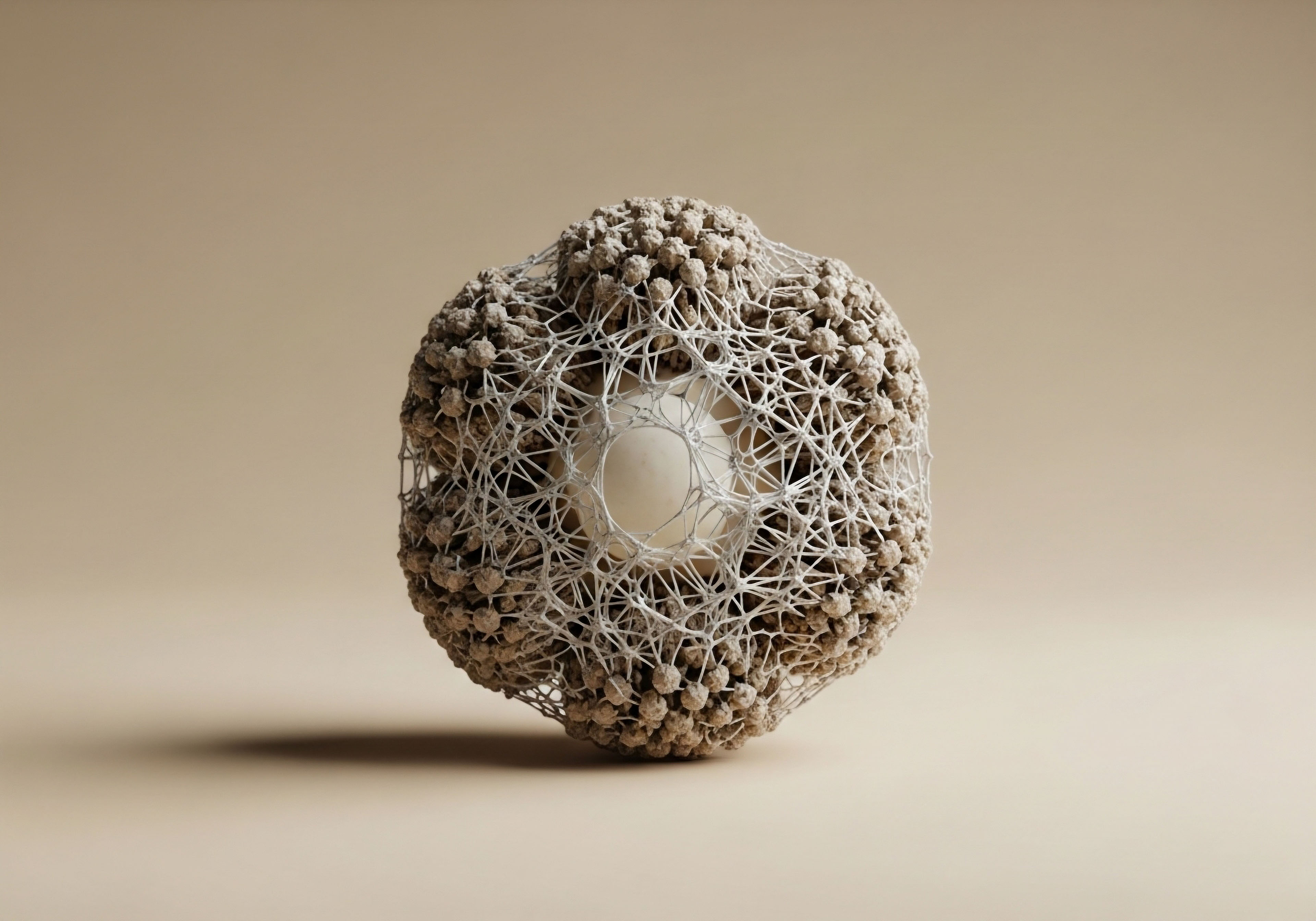

Fundamentals
Experiencing changes in your hair can be a deeply personal and often unsettling shift, particularly when you are actively working to optimize your health and vitality. Many individuals embarking on a journey with hormonal optimization protocols, such as testosterone replacement therapy, report a sense of unease or even distress when they notice alterations in their hair density or texture.
This concern is valid and speaks to the profound connection between our internal biochemical landscape and our outward presentation. Understanding the underlying biological mechanisms at play provides a pathway to addressing these concerns with precision and confidence.
The endocrine system orchestrates a complex symphony of internal messaging, with hormones acting as vital communicators. Testosterone, a primary androgen, plays a central role in numerous physiological processes, including muscle mass maintenance, bone density, mood regulation, and sexual function.
When testosterone levels decline, whether due to age or other factors, individuals may experience a constellation of symptoms that significantly impact their quality of life. Testosterone replacement therapy (TRT) is a clinical strategy designed to restore these levels, aiming to alleviate symptoms and improve overall well-being.
While TRT offers substantial benefits for many, it can also introduce changes in the body’s hormonal equilibrium that affect hair follicles. Hair growth is a cyclical process, influenced by a delicate balance of genetic predispositions and hormonal signals. Androgens, a class of hormones that includes testosterone, are key regulators of this cycle. The specific androgen most commonly associated with hair follicle miniaturization, a hallmark of androgenic alopecia, is dihydrotestosterone (DHT).
Hair changes during hormonal optimization are a valid concern, reflecting the intricate link between internal biochemistry and outward appearance.

The Role of Dihydrotestosterone in Hair Follicle Biology
Testosterone itself does not directly cause androgenic alopecia. Instead, a significant portion of circulating testosterone is converted into DHT by an enzyme called 5-alpha reductase. This enzyme exists in two primary forms within the human body ∞ Type 1 and Type 2.
Type 2 5-alpha reductase is predominantly found in the hair follicles of the scalp, as well as in the prostate gland and genital skin. DHT is a considerably more potent androgen than testosterone, possessing a much higher affinity for androgen receptors located within the hair follicle cells.
When DHT binds to these receptors in genetically susceptible hair follicles, it initiates a process of miniaturization. This means the hair follicle progressively shrinks, producing thinner, shorter, and less pigmented hairs over time. Eventually, the follicle may cease producing hair altogether. This sensitivity to DHT is largely genetically determined, explaining why some individuals experience significant hair thinning while others on similar TRT protocols do not.
The introduction of exogenous testosterone through TRT can lead to an increase in overall androgenic activity within the body. This elevated androgenic environment can result in a greater conversion of testosterone to DHT, potentially accelerating the miniaturization process in individuals with a genetic predisposition to androgenic alopecia. Understanding this biochemical pathway is the initial step in developing targeted strategies to mitigate unwanted hair changes while continuing to receive the benefits of hormonal support.

Understanding Hair Growth Cycles
Hair follicles undergo a continuous cycle of growth, regression, and rest. This cycle consists of three main phases:
- Anagen Phase ∞ This is the active growth phase, lasting from two to seven years. During this period, hair cells divide rapidly, leading to hair lengthening.
- Catagen Phase ∞ A transitional phase lasting about two to three weeks. Hair growth stops, and the outer root sheath shrinks and attaches to the hair root.
- Telogen Phase ∞ The resting phase, typically lasting around three months. Old hair sheds, and new hair begins to grow from the same follicle.
Androgens, particularly DHT, can shorten the anagen phase and prolong the telogen phase in susceptible follicles. This leads to a higher proportion of hairs in the resting or shedding phase, resulting in noticeable thinning and reduced hair density. The goal of clinical strategies for managing TRT-induced hair changes is to counteract this androgenic influence on the hair cycle, preserving the anagen phase and supporting robust hair growth.


Intermediate
Addressing hair changes associated with testosterone replacement therapy requires a thoughtful, individualized approach that balances the benefits of hormonal optimization with the desire to maintain hair health. Clinical strategies focus on modulating the androgenic signals at the hair follicle level, often without compromising systemic testosterone levels. This involves a precise understanding of how various agents interact with the body’s biochemical pathways.

Pharmacological Interventions Targeting 5-Alpha Reductase
The most direct approach to mitigating DHT-induced hair miniaturization involves inhibiting the 5-alpha reductase enzyme. This reduces the conversion of testosterone to DHT, thereby lowering the concentration of the more potent androgen at the hair follicle. Two primary medications are utilized for this purpose:
Finasteride is a selective inhibitor of the Type 2 5-alpha reductase enzyme. This enzyme subtype is primarily responsible for DHT production in the scalp and prostate. By blocking Type 2 5-alpha reductase, finasteride significantly reduces scalp DHT levels, which can slow or even reverse hair miniaturization in many individuals. Clinical studies have demonstrated its efficacy in treating androgenic alopecia in men.
Dutasteride inhibits both Type 1 and Type 2 5-alpha reductase enzymes. Its broader inhibitory action results in an even greater reduction in systemic and scalp DHT levels compared to finasteride. This comprehensive blockade can offer more pronounced effects on hair preservation for some individuals. Both finasteride and dutasteride are typically administered orally, with dosages tailored to the individual’s response and tolerance.
Targeting the 5-alpha reductase enzyme with medications like finasteride or dutasteride can effectively reduce DHT levels at the hair follicle, preserving hair density.
When considering these agents within a TRT protocol, the objective is to reduce the localized androgenic impact on hair follicles while maintaining therapeutic testosterone levels for overall well-being. Regular monitoring of both testosterone and DHT levels, alongside clinical assessment of hair density, guides the adjustment of these interventions.

Topical Therapies for Hair Support
Beyond systemic enzyme inhibition, topical agents can directly stimulate hair growth and improve follicle health. These therapies work through different mechanisms, often complementing the effects of oral medications.
Minoxidil is a topical solution or foam that acts as a vasodilator, increasing blood flow to the scalp. This enhanced circulation delivers more oxygen and nutrients to the hair follicles, promoting their health and extending the anagen phase of the hair growth cycle. Minoxidil can be applied directly to the scalp, and it is effective for both men and women experiencing hair thinning. Its mechanism is not directly hormonal, making it a valuable adjunctive therapy for TRT users.
Another topical approach involves ketoconazole shampoo. While primarily an antifungal agent, ketoconazole has demonstrated anti-androgenic properties when applied topically to the scalp. It can help reduce the local production of DHT and may also possess anti-inflammatory effects that benefit scalp health, creating a more favorable environment for hair growth. This shampoo is typically used a few times per week as part of a comprehensive hair management strategy.

Adjunctive Clinical Strategies
A holistic approach to managing TRT-induced hair changes extends beyond pharmacological interventions to include other supportive measures. These strategies aim to optimize the scalp environment and provide additional growth signals to hair follicles.
Platelet-Rich Plasma (PRP) therapy involves drawing a small amount of the patient’s blood, processing it to concentrate the platelets, and then injecting this platelet-rich plasma into the scalp. Platelets contain numerous growth factors that can stimulate hair follicle activity, promote healing, and potentially reverse miniaturization. PRP is a promising option for individuals seeking non-pharmacological or complementary treatments.
Low-level laser therapy (LLLT), delivered via devices such as laser combs or caps, uses specific wavelengths of light to stimulate cellular activity within hair follicles. This photobiomodulation can increase energy production in cells, reduce inflammation, and extend the anagen phase, thereby promoting hair growth and increasing hair density. LLLT is a non-invasive option that can be used at home.
The following table summarizes common clinical strategies for managing TRT-induced hair changes:
| Strategy Category | Primary Agents/Methods | Mechanism of Action | Application Method |
|---|---|---|---|
| 5-Alpha Reductase Inhibition | Finasteride, Dutasteride | Reduces conversion of testosterone to DHT, lowering androgenic impact on follicles. | Oral tablet |
| Topical Growth Stimulation | Minoxidil | Increases blood flow to scalp, extends anagen phase. | Topical solution/foam |
| Scalp Health Modulation | Ketoconazole Shampoo | Anti-androgenic and anti-inflammatory effects on scalp. | Topical shampoo |
| Regenerative Therapy | Platelet-Rich Plasma (PRP) | Delivers growth factors to stimulate follicle activity. | Scalp injection |
| Photobiomodulation | Low-Level Laser Therapy (LLLT) | Stimulates cellular activity, reduces inflammation, extends anagen. | Device (comb/cap) |

Personalized Protocol Development
Developing a personalized protocol for managing TRT-induced hair changes involves a careful assessment of several factors. These include the individual’s genetic predisposition to hair loss, the extent of current hair thinning, the specific TRT protocol being followed, and personal preferences regarding treatment modalities. A clinician will typically evaluate baseline hair status, discuss expectations, and monitor progress through regular follow-up appointments.
For men on standard TRT protocols involving weekly intramuscular injections of Testosterone Cypionate, along with Gonadorelin and Anastrozole, the addition of a 5-alpha reductase inhibitor like finasteride is a common consideration if hair changes become a concern. The precise dosage and frequency of these medications are adjusted based on individual response and laboratory markers.
Women undergoing testosterone replacement therapy, often with Testosterone Cypionate via subcutaneous injection or pellet therapy, may also experience hair changes. Their protocols for managing hair thinning might involve lower doses of 5-alpha reductase inhibitors, or a greater reliance on topical minoxidil and adjunctive therapies, given the different hormonal landscape and potential sensitivities.


Academic
The sophisticated interplay between androgens and hair follicle dynamics presents a compelling area of study, particularly when considering the clinical implications of testosterone replacement therapy. To truly comprehend the strategies for managing TRT-induced hair changes, one must delve into the molecular and cellular mechanisms that govern hair growth and androgen sensitivity. This involves an examination of receptor kinetics, enzymatic pathways, and the intricate feedback loops within the endocrine system.

Androgen Receptor Sensitivity and Hair Follicle Miniaturization
The susceptibility of hair follicles to androgenic miniaturization is not solely dependent on circulating DHT levels, but also on the sensitivity and expression of androgen receptors within the dermal papilla cells of the hair follicle. These receptors are ligand-activated transcription factors, meaning they bind to androgens (like DHT) and then translocate to the cell nucleus to regulate gene expression. In genetically predisposed individuals, hair follicles on the scalp exhibit a higher density and activity of these androgen receptors.
When DHT binds to these highly sensitive receptors, it triggers a cascade of intracellular events that ultimately lead to the production of inhibitory growth factors and a reduction in stimulatory growth factors. This shifts the hair follicle from a robust anagen (growth) phase to a shorter anagen phase and a prolonged telogen (resting/shedding) phase.
The result is the progressive miniaturization of the follicle, leading to thinner, weaker hairs over successive cycles. The clinical strategies employing 5-alpha reductase inhibitors directly interrupt the supply of the most potent ligand for these receptors.
Hair follicle sensitivity to androgens, mediated by receptor expression, dictates the extent of miniaturization, making receptor modulation a key therapeutic target.

Pharmacodynamics of 5-Alpha Reductase Inhibitors
The two primary 5-alpha reductase inhibitors, finasteride and dutasteride, exhibit distinct pharmacodynamic profiles that influence their clinical application.
- Finasteride ∞ This compound is a competitive inhibitor of Type 2 5-alpha reductase. Its binding to the enzyme prevents the conversion of testosterone to DHT. While highly effective at reducing scalp DHT, it has a relatively short half-life, necessitating daily dosing to maintain consistent enzyme inhibition. The reduction in serum DHT typically ranges from 60-70%.
- Dutasteride ∞ This agent is a dual inhibitor, targeting both Type 1 and Type 2 5-alpha reductase isoforms. This broader inhibition leads to a more profound reduction in serum DHT, often exceeding 90%. Its longer half-life allows for less frequent dosing, sometimes every other day or even less often, depending on the clinical context. The Type 1 enzyme is also present in sebaceous glands, and its inhibition may contribute to reduced scalp oiliness in some individuals.
The choice between finasteride and dutasteride often depends on the desired level of DHT suppression, individual response, and potential side effect profiles. While both are generally well-tolerated, clinicians carefully monitor for any systemic effects, particularly in the context of ongoing TRT.

Systemic Considerations and the HPG Axis
Testosterone replacement therapy inherently influences the Hypothalamic-Pituitary-Gonadal (HPG) axis, the central regulatory system for endogenous hormone production. Exogenous testosterone typically suppresses luteinizing hormone (LH) and follicle-stimulating hormone (FSH) production from the pituitary gland, leading to a reduction in testicular testosterone synthesis. This is why adjunctive medications like Gonadorelin are often included in TRT protocols for men, to maintain testicular function and fertility by stimulating LH and FSH release.
When 5-alpha reductase inhibitors are introduced, they primarily act on the peripheral conversion of testosterone to DHT, rather than directly impacting the HPG axis or the exogenous testosterone administration. This means that while scalp DHT levels are reduced, the therapeutic benefits of systemic testosterone are largely preserved. However, a slight increase in serum testosterone may be observed due to reduced conversion to DHT, which the body’s feedback mechanisms may attempt to compensate for.
The management of TRT-induced hair changes is a delicate balancing act. The goal is to mitigate the localized androgenic effects on hair follicles without undermining the systemic benefits of testosterone optimization. This requires a deep understanding of the pharmacokinetics and pharmacodynamics of each agent, as well as the individual’s unique physiological response.
Consideration of the genetic component is paramount. Genetic testing can identify polymorphisms in the androgen receptor gene or 5-alpha reductase gene that predispose individuals to androgenic alopecia. This information can guide proactive management strategies, allowing for earlier intervention with targeted therapies. For instance, individuals with a strong genetic predisposition might benefit from initiating a 5-alpha reductase inhibitor concurrently with TRT, rather than waiting for hair changes to manifest.
The table below illustrates the relative impact of different interventions on key hormonal markers:
| Intervention | Effect on Serum Testosterone | Effect on Serum DHT | Effect on Scalp DHT | Effect on Hair Follicle Miniaturization |
|---|---|---|---|---|
| Testosterone Replacement Therapy (TRT) | Increases | Increases | Increases | Accelerates (in susceptible individuals) |
| Finasteride | Slightly Increases | Decreases (60-70%) | Decreases Significantly | Reduces/Reverses |
| Dutasteride | Slightly Increases | Decreases (>90%) | Decreases Markedly | Reduces/Reverses More Significantly |
| Minoxidil (Topical) | No Direct Effect | No Direct Effect | No Direct Effect | Stimulates Growth, Extends Anagen |
The complexity of managing TRT-induced hair changes underscores the necessity of a highly personalized and clinically supervised approach. It involves not only addressing the visible symptom but also understanding the intricate biochemical pathways that govern hair health within the broader context of hormonal equilibrium. This precision medicine approach ensures that individuals can pursue optimal vitality without compromise.

References
- Kaufman, K. D. (1998). Clinical efficacy of finasteride in men with androgenetic alopecia. European Journal of Dermatology, 8(5), 335-339.
- Olsen, E. A. et al. (2006). The importance of dual 5alpha-reductase inhibition in the treatment of androgenetic alopecia ∞ results of a randomized placebo-controlled study of dutasteride versus finasteride. Journal of the American Academy of Dermatology, 55(6), 1014-1023.
- Messenger, A. G. & Rundegren, L. (2004). Minoxidil ∞ mechanisms of action on hair growth. British Journal of Dermatology, 150(2), 186-194.
- Imperato-McGinley, J. & Zhu, Y. S. (2002). Androgen and molecular mechanisms of androgen action in male pattern baldness. Journal of Investigative Dermatology Symposium Proceedings, 7(1), 19-23.
- Gormley, G. J. et al. (1992). The effect of finasteride in men with benign prostatic hyperplasia. New England Journal of Medicine, 327(17), 1185-1191.
- Clark, R. V. et al. (2004). Dose-response relationship of dutasteride on serum dihydrotestosterone and testosterone concentrations in men with benign prostatic hyperplasia. Journal of Clinical Endocrinology & Metabolism, 89(1), 217-228.
- Sinclair, R. D. (2004). Male pattern hair loss ∞ a scientific and medical approach. Medical Journal of Australia, 181(8), 441-445.
- Trueb, R. M. (2002). Molecular mechanisms of androgenetic alopecia. Experimental Gerontology, 37(8-9), 981-990.

Reflection
Considering your own biological systems, particularly the intricate dance of hormones, can feel like peering into a complex internal map. The knowledge shared here about managing hair changes during hormonal optimization is not merely a collection of facts; it represents a compass for your personal health journey. Each individual’s response to therapy is unique, a testament to the biological variability that makes us who we are.
This exploration serves as a starting point, inviting you to engage more deeply with your own physiology. Understanding the mechanisms behind hair changes, and the available clinical strategies, empowers you to have more informed conversations with your healthcare provider. Your path to reclaiming vitality and function is a collaborative one, built on shared understanding and precise, personalized guidance.
The journey toward optimal well-being is continuous, marked by learning and adaptation. May this information serve as a beacon, guiding you toward a more complete and integrated understanding of your body’s remarkable capabilities.



